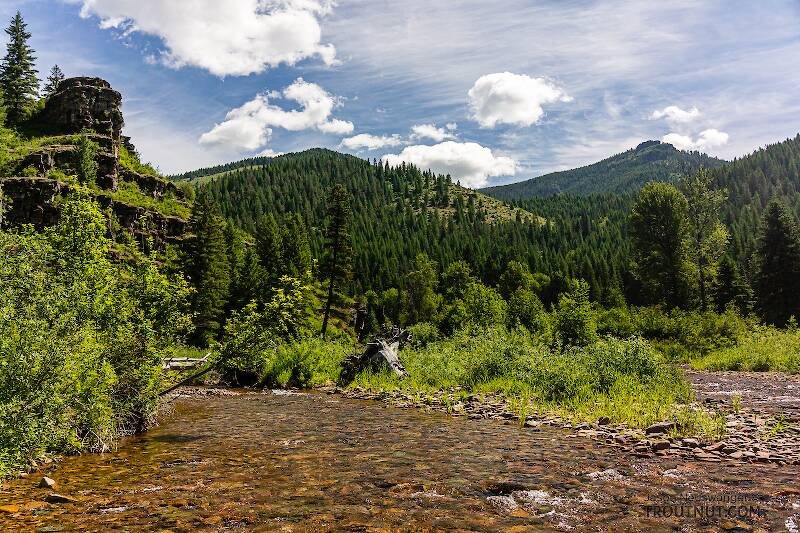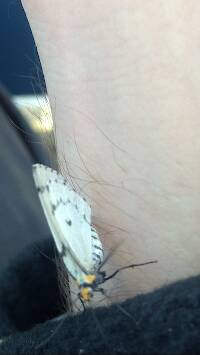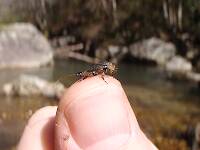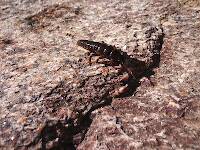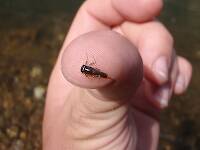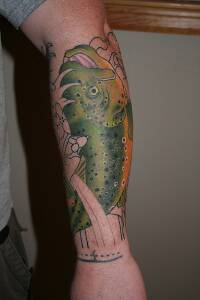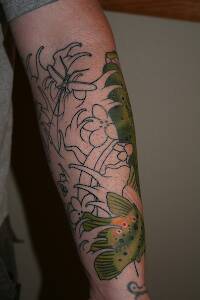
Blue-winged Olives
Baetis
Tiny Baetis mayflies are perhaps the most commonly encountered and imitated by anglers on all American trout streams due to their great abundance, widespread distribution, and trout-friendly emergence habits.
Featured on the forum

Troutnut is a project started in 2003 by salmonid ecologist Jason "Troutnut" Neuswanger to help anglers and
fly tyers unabashedly embrace the entomological side of the sport. Learn more about Troutnut or
support the project for an enhanced experience here.
Snowsquatch on Jul 8, 2012July 8th, 2012, 10:01 pm EDT
Hi, this is my first post on the site.
I was on a new river today not fishing just scouting and exploring with a friend. Anyhow I was looking for trout forage along the bank on this gem of a river section. I found a large group of stonefly shucks, mostly golden/ yellow SF's but I then found this Huge Green Stonefly shuck.( thought it could be a Dragonfly but wasn't sure.)
I brought it home to i.d. because I don't have a camara just a phone cam. searching Troutnut I think I identified it as a Gaint Salmonfly.
My question is, anyone here familiar with Northern Ontario aquatic insects
and is it possible that it is a Gaint Salmonfly?.
I have pics on my phone but not of the best quality, and the shucks are damaged from the trip back so I didn't post them. any help is appreciated.
Cheers.
I was on a new river today not fishing just scouting and exploring with a friend. Anyhow I was looking for trout forage along the bank on this gem of a river section. I found a large group of stonefly shucks, mostly golden/ yellow SF's but I then found this Huge Green Stonefly shuck.( thought it could be a Dragonfly but wasn't sure.)
I brought it home to i.d. because I don't have a camara just a phone cam. searching Troutnut I think I identified it as a Gaint Salmonfly.
My question is, anyone here familiar with Northern Ontario aquatic insects
and is it possible that it is a Gaint Salmonfly?.
I have pics on my phone but not of the best quality, and the shucks are damaged from the trip back so I didn't post them. any help is appreciated.
Cheers.
"It's not the mountain we conquer, but ourselves"
Taxon on Jul 9, 2012July 9th, 2012, 4:19 am EDT
Snowsquatch-
NatureServExplorer lists both Pteronarcys dorsata (American Salmonfly) and Pteronarcys proteus (Appalachian Salmonfly) as being present in Ontario.
NatureServExplorer lists both Pteronarcys dorsata (American Salmonfly) and Pteronarcys proteus (Appalachian Salmonfly) as being present in Ontario.
Snowsquatch on Jul 9, 2012July 9th, 2012, 11:19 am EDT
Thank you Taxon for informing me of NatureServ site.
"It's not the mountain we conquer, but ourselves"
Sayfu
Posts: 560
Posts: 560
Sayfu on Aug 8, 2012August 8th, 2012, 8:16 am EDT
Not a true bug nut, but...I would think the big Salmonfly, and the golden, are not that much apart in size. Although you could be on each end of the size range of both.
Entoman on Sep 4, 2012September 4th, 2012, 6:39 pm EDT
Hi Sayfu -
I suspect that may be true in some watersheds where as you said extremes in size range may meet. This could be especially confusing when comparing different genders or development years. However, I've collected some pretty big mature Pteronarcys female nymphs from the Deschutes, Madison, and even Hat Creek over the years. Some of them reach almost 50mm with abdomens bigger around than a pencil! In terms of mass, I've never seen a Golden anywhere near their size. Though the Golden females can approach 40mm (interesting note: I've usually found these big ones in streams where Pteronarcys is lacking), they are much less corpulent, especially when viewed from the side. The males are substantially smaller than the females in both families. I assume these comparisons hold for the eastern species as well?
I suspect that may be true in some watersheds where as you said extremes in size range may meet. This could be especially confusing when comparing different genders or development years. However, I've collected some pretty big mature Pteronarcys female nymphs from the Deschutes, Madison, and even Hat Creek over the years. Some of them reach almost 50mm with abdomens bigger around than a pencil! In terms of mass, I've never seen a Golden anywhere near their size. Though the Golden females can approach 40mm (interesting note: I've usually found these big ones in streams where Pteronarcys is lacking), they are much less corpulent, especially when viewed from the side. The males are substantially smaller than the females in both families. I assume these comparisons hold for the eastern species as well?
"It's not that I find fishing so important, it's just that I find all other endeavors of Man equally unimportant... And not nearly as much fun!" Robert Traver, Anatomy of a Fisherman
Quick Reply
Related Discussions
Topic
Replies
Last Reply
1
Oct 28, 2008
by GONZO
by GONZO
3
Apr 26, 2010
by RyanBednar
by RyanBednar
0
May 19, 2007
by GONZO
by GONZO

